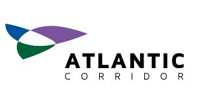RFC ATLANTIC NEWS
European rail freight corridors conquer new territories
Transport Ministers of thirteen countries held a signing ceremony on October 8, 2014, in the margins of the Transport Council in Luxembourg attended by Vice President Siim Kallas. The aim of this event is to strengthen the Executive Boards of four rail freight corridors and extend the scope of these corridors crossing Europe.

As foreseen by Regulation (EU) No 913/2010, the rail freight corridors aim to facilitate the organisation of traffic and thus allow easier rail interconnection of the most important European logistical and industrial hubs. The corridors bring major enhancements to international freight services.
Under this new development, railway undertakings and other applicants can now find all useful information concerning the corridor from one single point of contact. Capacity for international freight trains is shown transparently in a catalogue of international pre-arranged train paths (PaP) and train paths ordering/booking and allocation can be done via the corridor’s one-stop-shop in one single operation. Applicants will also be better informed about infrastructure works, which shall be co-ordinated more efficiently along the corridors by the infrastructure managers.
The governance structure of these corridors brings together representatives of the authorities of the Member States concerned as an Executive Board, and infrastructure managers and capacity allocation bodies as a Management Board. Each Management Board has two Advisory Groups, one bringing together the railway undertakings and the other bringing together the ports and terminals of the corridor. With this client-oriented approach these corridors now possess all the tools to provide a major modal shift to rail.
With the signing of the Agreements regarding the Executive Boards, the Ministers have strengthened the legal basis of their four respective Boards in accordance with Regulation (EU) No 913/2010 and confirmed their authority to take legally-binding decisions. The responsibilities and tasks of the Executive Boards have also been clarified. In addition, the Boards renamed their corridors with the official names stated in Regulation (EU) No 1316/2013 and welcomed the new Member States1 involved. Accordingly the United Kingdom joined the North Sea Mediterranean rail freight corridor and Germany joined the Atlantic rail freight corridor. Furthermore the Czech Republic joined the North Sea Baltic Rail Freight Corridor in accordance with a common agreement of the Member States involved and based on the positive results of a Transport Market study of this corridor.
The four corridors constitute a good example of successful international co-operation in rail freight development. The extensions further illustrate the commitment from Member States to promote sustainable transport at the European level.
For more information:
Rail Freight Corridor Rhine-Alpine
Rail Freight Corridor North Sea-Mediterranean
Claire Hamoniau
Atlantic Rail Freight Corridor
Ana Matos
Rail Freight Corridor North Sea Baltic
Katarzyna Rocka
Federal Public Service Mobility and Transport
Thomas De Spiegelaere – Spokesperson NL/EN
Vooruitgangsstraat 56, 1210 Brussels
Tel.: 02/2773406
Mobile: 0485/195963
E-mail: pers@mobilit.fgov.be







